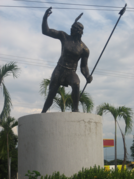Valledupar | |
|---|---|
Municipality and city | |
From above and from left to right: Aerial panoramic view, Monument to the Revolution in March, Calle 15 in the Historic Center, Statue of Cacique Upar and the Guatapuri River | |
| Nickname: Ciudad de los Santos Reyes de Valledupar (City of the Holy Kings of Valledupar) | |
 Location in the Department of Cesar. Municipality (dark gray), City (red). | |
| Coordinates: 10°29′N 73°15′W / 10.483°N 73.250°W | |
| Country | Colombia |
| Region | Caribbean |
| Department | Cesar |
| Foundation | January 6, 1550 |
| Government | |
| • Mayor | Ernesto Miguel Orozco Durán" (2024–2028) (partido Conservador) |
| Area | |
• Municipality and city | 4,977.66 km2 (1,921.89 sq mi) |
| • Urban | 47.53 km2 (18.35 sq mi) |
| Elevation | 168 m (551 ft) |
| Population (2018 census)[1] | |
• Municipality and city | 490,075 |
| • Density | 98/km2 (250/sq mi) |
| • Urban | 431,794 |
| • Urban density | 9,100/km2 (24,000/sq mi) |
| Demonym | Vallenato |
| Time zone | UTC-05 (Eastern Time Zone) |
| Postal code | 200001-200005 |
| Area code | 57 + 5 |
| Climate | Aw |
| Website | Official website (in Spanish) |
Valledupar (Spanish pronunciation: [baʝeðuˈpaɾ]) is a city and municipality in northeastern Colombia. It is the capital of Cesar Department. Its name, Valle de Upar (Valley of Upar), was established in honor of the Amerindian cacique who ruled the valley; Cacique Upar. The city lies between the mountains of the Sierra Nevada de Santa Marta and the Serranía del Perijá to the borders of the Guatapurí and Cesar rivers.[2]
Valledupar is an important agricultural, cattle raising, coal mining and agro-industrial center for the region between the Departments of Cesar and southern municipalities of La Guajira Department, formerly known as the Padilla Province. Valledupar is notable as the cradle of vallenato music, representative of the Colombian culture. The city hosts the Vallenato Legend Festival.
During the 1980s, 1990s and early 2000s, the city suffered during the Colombian Armed Conflict, with numerous kidnappings,[3] thousands of people forced out[4] and failure to control crime.
Valledupar has one of Colombia's most modern maximum security prisons.[5]
- ^ "INFORMACIÓN CAPITAL" (PDF) (in Spanish). Departamento Administrativo Nacional de Estadística (DANE). Retrieved 2024-01-14.
- ^ Alcaldia Valledupar: Historia de Valledupar (in Spanish) valledupar.gov.co Accessed 8 October 2006.
- ^ "From Colombia's Upper Class, Rebel and His Foil Diverged", New York Times(in Spanish) Accessed 8 October 2006.
- ^ "Viviendas para desplazados de Valledupar", Presidencia de Colombia (in Spanish), Accessed 8 October 2006.
- ^ INPEC: Instituto Nacional Penitenciario; listado de Carceles (in Spanish) inpec.gov.co Accessed 8 October 2006.







